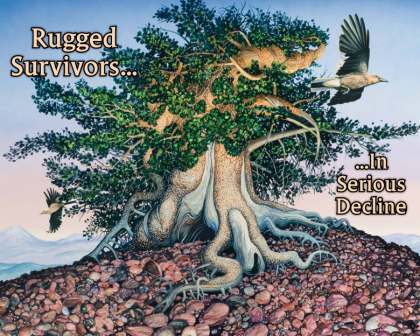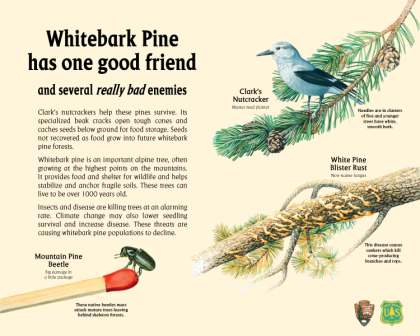2008 Whitebark Pine Interpretation Signs
Project: Whitebark Pine Interpretation Signs
 Agency/Forest or Park/District: Deschutes/Mt. Hood National Forests and Crater Lake National Park
Agency/Forest or Park/District: Deschutes/Mt. Hood National Forests and Crater Lake National Park
Project coordinators: Chris Jensen, Kristen Chadwick
Contact:Chris Jensen, Genetics, Deschutes and Ochoco NF, 541-383-4779 cejensen@fs.fed.us.
Kristen Chadwick, Pathologist, FHP, Deschutes NF, 541-383-5587 kchadwick@fs.fed.us
Cooperators
Robin Gyorgyfalvy, Landscape Architect, Deschutes NF, 541-383-4786
Laura E.Hudson, Ph.D, Terrestrial Ecologist, Crater Lake National Park, 594-3072
Jeanne Rice, Ecologist – Natural Resources, Mt. Hood NF, 503-668-1668
Source of funding
FHP: $ 6,000
Supplemental funding: $9,000 from Crater Lake National Park in-kind support.
Total sign fabrication and delivery costs: $8,120.
Objectives
To increase species awareness and provide information to the public through visual interpretation at heavily visited sites.
Acres/ha treated N/A
Methods (Proposed)
Sign development would use illustrations and artwork that pertain directly to each site and highlight the unique environment of whitebark pine. The signs would utilize a mix of these illustrations and some brief written descriptions to portray the threats and raise awareness about our whitebark pine stands. There is an intact whitebark community including many whitebark pines of various age classes and vigor in the immediate proximity of the intended sign positions, as well as an abundance of Clark’s nutcrackers. In cooperation with Mt. Bachelor and Crater Lake National Park, interpretive signs would be designed and installed to give an overview of whitebark ecology as well as issues. For each site a sign that is common to all three places would be installed with the ecology of whitebark pine emphasized. We will also have an additional smaller sign that highlight the threats to whitebark pine communities, specifically mountain pine beetle and blister rust. For each area we plan to have one smaller sign that is specific to that site which highlights a research project of something ecologically unique to that site. For example, on Mt. Bachelor we could highlight the seed planting trials that have been established to test methods of rust-resistant seed deployment to remote areas. The signs at Crater Lake could highlight the research Michael Murray has done surrounding fire ecology of whitebark pine stands at Crater Lake, and the sign at Newberry National Volcanic Monument could highlight the differences in rust infection levels at the different elevation bands on Paulina Peak.
We would integrate illustrations and artwork contracted by either a local Oregon artist or another source into the signs designed by our Silviculture group, Forest Pathologists, and Landscape architect for a unique approach and message. In addition, at the Mt. Bachelor site, a summer Forest Field Ranger is available to integrate the subject into daily on-site presentations given to the public.
The center sign would be 24″ x 36″ with two smaller signs (we have not yet determined the size of the smaller signs). Signs would be 1/2″ thickness and done with dHPL Graphic, 8-color enhanced printing color sign with a metal edge. These signs have been shown to hold up to sever weather conditions as proven with the Scenic Byways signs.
Planting? If so, source of seedlings? Resistance?N/A
Outcome:
(2008) Initial conceptual design work was partially completed. A purchase order was arranged and funding committed to a renowned local artist for sign artwork and layout. Unfortunately, funding was withdrawn in July to cover the cost of wildfire suppression, and the signed purchase order cancelled. As a result the project was put on hold until the funding is replaced or restored.
(2009) Using restored funds, the project was implemented with 8 panels fabricated. The signs are each 30” x 24” mounted on weather proof pedestals. Artwork was accomplished using a local artist, with graphics layout assistance from another out-sourced professional.
(2010) Several occurrences have prevented field installations. Crater Lake National Park made a determination that the signs did not meet certain interpretive standards, and put the installation on hold.
The installation at Newberry National Volcanic Monument has been delayed from administrative issues regarding a re-design of the summit parking vicinity. Installation is scheduled in July of 2014 using a YCC crew.
The location for the panels at Mt. Bachelor was delayed due to their launching of the Summer season bike and disc course locations. A final location has been decided and installation is planned for 2014.
Field installation at Cloudcap Inn, Mt. HOOD NF has been on hold due to personnel shortages for installation.
Monitoring since completion of the project
Post installation monitoring for vandalism will occur annually
Dates – Panels to be installed summer of 2014 where permitted.
Will outcome meet goals? Yes
Future actions/follow up?
The panels were submitted to the Washington Office Celebrating Wildflowers Website, which has a collection of Interpretive panels for viewing. http://www.fs.fed.us/wildflowers/features/panels.shtml
Miscellaneous comments:
The panels were designed to install as a complimentary pair adjacent to each other